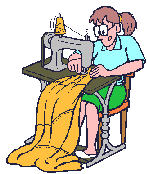Post by ellise on Jun 14, 2005 8:02:57 GMT 10
Planting for fragrance? Try planting the following: Carnations, Pinks, Mignonettes, Lavender, Fragrant Nicotiana, Violas, Ornamental Basil, Rosemary, Sweet William, English Wallflower.
Save your lawn. To minimize damage to your lawn, mix sand, dirt, or kitty litter with salt when putting it on your walks and driveway.
Plant for Butterflies. To attract butterflies to your garden, plant lots of colorful flowers. Butterflies seem to be especially attracted to purple, yellow, orange, and red. Keep the colors growing all season by growing different varieties that bloom at different times.
When picking sweet potatoes, choose the dark skinned ones. The darker skinned are known to be sweeter and more moist than the lighter skinned variety.
Autumn is a good time to trim trees and shrubs that touch the house and to remove leaves from gutters.
An African Violet with leaves growing horizontally is telling you the amount of light it receives is perfect. Leaves growing upwards or downwards are sending a message to change location.
A cucumber that grows in dry, hot weather can turn bitter. Chop a piece off the stem end and taste. Sometimes the peel, too, must be removed
Let carrots grow until maturity. Before this time they have not developed enough sugar for optimum flavor.
Flowers in a cut arrangement look pleasantly balanced when buds are at the top of the bouquet, half-opened flowers in the middle, and opened blooms at the base.
Dirty and rusty garden tools need to be kept clean, not for appearance sake but because pitted metal attracts soil and slows the work. Use rust remover and a wire brush. Pass a hand file over cutting edges. Then sand handles and wipe on linseed oil.
It is time to "work" the soil in spring when you squeeze a handful and it crumbles. If the soil forms a ball, it is still too wet to start gardening.
When building a garden, use newspaper under your loam and topsoil. The newspaper will kill all the weeds and grass underneath, plus it will compost into great mulch that roots can grow through.
Nature’s fertilizer is there for the taking. Don’t burn leaves; use them to improve garden soil. Chop the leaves up with a lawn mower. Make a compost pile and store your leaves there. Spade into the garden as needed.
Try starting seeds in eggshell halves. It’s economical and earth-friendly. Store planted shells in egg carts so they can easily be moved to sunny spots. Plant as is. Roots break through and the decomposed shell acts as fertilizers.
Instead of using insecticides, try planting marigolds, basil, savory, horseradish, mint, onions, garlic, and chives near your garden. These plants’ (and many others) natural and root secretions repel some insects.
Taken from Farmer's Almanac 2005
Save your lawn. To minimize damage to your lawn, mix sand, dirt, or kitty litter with salt when putting it on your walks and driveway.
Plant for Butterflies. To attract butterflies to your garden, plant lots of colorful flowers. Butterflies seem to be especially attracted to purple, yellow, orange, and red. Keep the colors growing all season by growing different varieties that bloom at different times.
When picking sweet potatoes, choose the dark skinned ones. The darker skinned are known to be sweeter and more moist than the lighter skinned variety.
Autumn is a good time to trim trees and shrubs that touch the house and to remove leaves from gutters.
An African Violet with leaves growing horizontally is telling you the amount of light it receives is perfect. Leaves growing upwards or downwards are sending a message to change location.
A cucumber that grows in dry, hot weather can turn bitter. Chop a piece off the stem end and taste. Sometimes the peel, too, must be removed
Let carrots grow until maturity. Before this time they have not developed enough sugar for optimum flavor.
Flowers in a cut arrangement look pleasantly balanced when buds are at the top of the bouquet, half-opened flowers in the middle, and opened blooms at the base.
Dirty and rusty garden tools need to be kept clean, not for appearance sake but because pitted metal attracts soil and slows the work. Use rust remover and a wire brush. Pass a hand file over cutting edges. Then sand handles and wipe on linseed oil.
It is time to "work" the soil in spring when you squeeze a handful and it crumbles. If the soil forms a ball, it is still too wet to start gardening.
When building a garden, use newspaper under your loam and topsoil. The newspaper will kill all the weeds and grass underneath, plus it will compost into great mulch that roots can grow through.
Nature’s fertilizer is there for the taking. Don’t burn leaves; use them to improve garden soil. Chop the leaves up with a lawn mower. Make a compost pile and store your leaves there. Spade into the garden as needed.
Try starting seeds in eggshell halves. It’s economical and earth-friendly. Store planted shells in egg carts so they can easily be moved to sunny spots. Plant as is. Roots break through and the decomposed shell acts as fertilizers.
Instead of using insecticides, try planting marigolds, basil, savory, horseradish, mint, onions, garlic, and chives near your garden. These plants’ (and many others) natural and root secretions repel some insects.
Taken from Farmer's Almanac 2005




